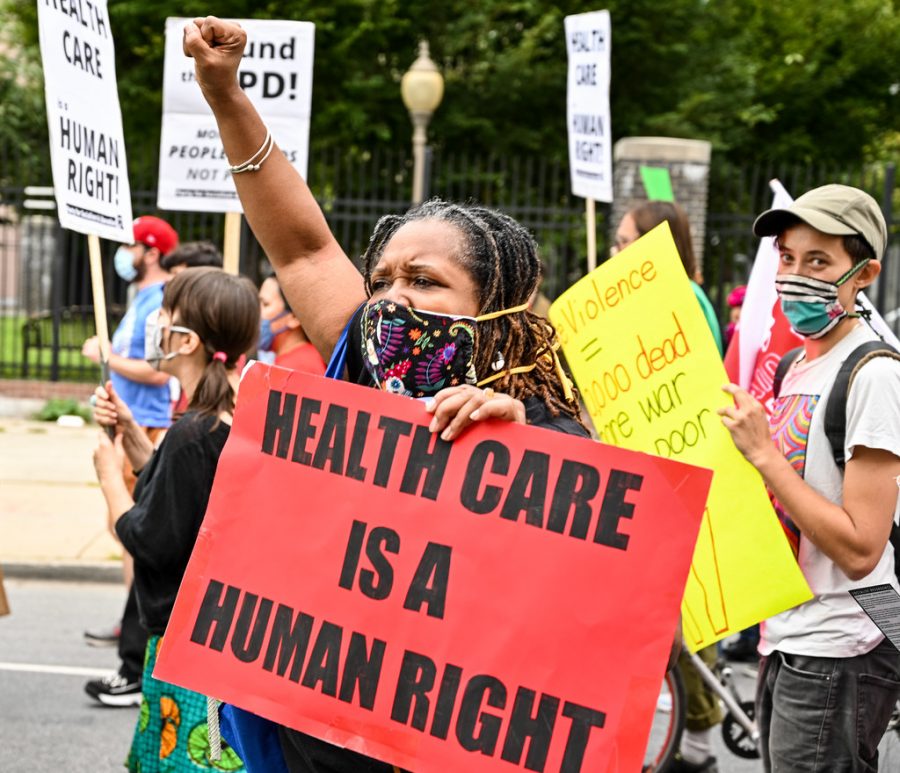Election feature: Latinx health policy
Protestors march during the Philadelphia Medicaid March on Oct. 1
Oct 29, 2020
This article is part of The Carroll News Elections Series, written by the students of the Fundamentals of Journalism class. For more information on these series, check out this introduction!
The moment has come. You have COVID-19. It’s so bad that you can’t breathe properly and have no choice but to be hospitalized. Through nearly all of 2020, you’ve taken every measure to stay away from the virus. You’ve masked up, kept your distance and bought plenty of hand sanitizer, but somehow it slipped into your lungs to no fault of your own; life happens, after all. As a blue-dressed nurse leads you down the narrow hallways of a hospital filled with others just as sick, you can’t help being afraid. The sight of others hooked up to ventilators and fighting against their own cough are not what you pictured of your future in America to be. In the end, you get checked into another white curtain-walled room, knowing that even if you do survive this sickness, more problems lie ahead: You’re one of many Latinx Americans who have to pay off the expenses without health insurance.
For many in the U.S. right now, catching COVID-19 is not only a threat to their lives but also to their livelihoods. Without health coverage, patients could pay upwards of $40,000 for COVID-19 treatment depending on their situation, according to a FAIR Health report that detailed characteristics of healthcare claims related to the virus in 2020. This problem is compounded for Latinx people, one particular minority group that is already reeling from unusually high numbers of COVID-19 cases.
Not everyone has equal access to insurance. Similar to some American economic trends, members of certain social groups in the U.S., such as Latinx minorities are unjustly affected by the healthcare crisis. Immigration rules, lower-level jobs and lack of client-physician relationships all play a part in disadvantaging Latinx communities in the United States. With the presidential election focusing largely on public health, a rejection or support for plans like the Affordable Care Act could change many people’s situations drastically.
This disparity in race or ethnicity and insurance has fallen largely under the radar among other groundbreaking issues but is large nonetheless. In the 2019 U.S. census results, Latinx people had a higher percentage, 16.7% of uninsured people in the United States, than any other race. In comparison, Black people represented the second highest percentage, at 9.6%, meaning Latinx people are uninsured at a rate almost twice that of any other ethnic group. Using that statistic with the population count of 60.6 million Latinx people in the U.S., about 10 million people were uninsured as of 2019. Couple this statistic with an economic crisis due to the pandemic, and those 10 million are left in a more precarious position.
Even apart from COVID-19, the Latinx population is vulnerable to health issues. Cameron Rodriguez, a student at JCU who took part in an interview with students in a journalism class, recounted that he had recently felt a sharp, acute pain in his chest over the summer. He did what any normal person would do and went in for an exam to check if everything was working fine. Rodriguez had an electrocardiogram, or EKG, and an X-ray done to find that he had seriously pulled a muscle but would recover with some rest. So, Rodriguez went home and slept with peace of mind. However, only a week or so later, he opened a crisp $900 medical bill for the visit. The craziest part of this story? Rodriguez was on his family’s insurance, yet he still got a bill this large.
“I can’t imagine what that’s like for someone without the privilege I have of being on healthcare right now,” Rodriguez said, “especially those who are undocumented too.”
The life lesson here is to make sure to have insurance through your entire life right? While that may be the end goal in an ideal world, many in the Latinx population have a harder time than other social groups in acquiring and keeping insurance over their lifetime. Rules of immigration start these problems for some, as the code for entering the insurance marketplace requires documentation of some sort, according to Healthcare.gov. Those living undocumented often cannot pay the large amounts needed to hop through bureaucratic hoops in order to even look for insurance plans set up by the Affordable Care Act. Other means of getting insurance, such as straight from an insurer, are not usually an option for undocumented residents, since those plans are much higher priced.
Sociology Professor at Emory University Heeju Sohn explained even more reasons in an interview about her 2017 study focusing on disparities between races and insurance coverage. After reviewing trends, Sohn claims that two major changes make for these differences: job level and relationship barriers.
For job level, Sohn means that those who have white collar jobs often work at companies who support their health insurance even when furloughed for a period of time. While some Latinx people work in these jobs, many more are working blue collar jobs due to the “blue-collar ceiling” – a term coined by a study done at the University of California, Berkeley.
Relationship problems occur between Latinx minorities and physicians because of more frequent job changes among blue-collar workers. Whenever a change in job occurs, people tend to change insurance and get a new network of doctors. Those doctors might not know their new patient as well and cannot develop medical data. Another job change could occur and repeat the process. All of this change can lead to a drop in coverage overall or other problems, as Sohn explains.
“Throughout that process, there’s not an opportunity for the doctor to gain a medical history about a person’s condition. That can make an impact on the quality of care people can receive.”
So, what could change these disparities? Currently, these issues have come up quickly in regards to the 2020 election and the upcoming Supreme Court review of the Affordable Care Act. Before the ACA became law, qualification for insurance came largely through state-by-state discretion. The ACA set up a national qualification through documentation, which overall lowered the amount of documentation needed from the past.
The Supreme Court review on Nov. 10 will question the legislative branch’s taxing power of the ACA in relation to its individual mandate of buying insurance or paying a fee. Many Democrats believe if the ACA were to be declared unconstitutional, more Americans would become uninsured until another piece of legislation replaced it. For example, current incumbent for Cuyahoga County Council Cheryl Stevens voiced her opinion about the past and present presidential administrations in a recent interview:
“A best effort by a previous president was successful in getting healthcare to as many people as possible,” she stated. “The current administration is trying to kill the Affordable Care Act, which is not fair.”
The Latinx community has faced compounding disparities for health coverage over the years, and while the world of insurance can never be ideal, progressive legislation such as the Affordable Care Act has helped lower those disparities. Ultimately, the upcoming election might either reinforce that progress or negate it. If getting COVID-19 is bad enough, just imagine the financial burden afterwards. For many Latinx Americans, that burden is a looming reality.












